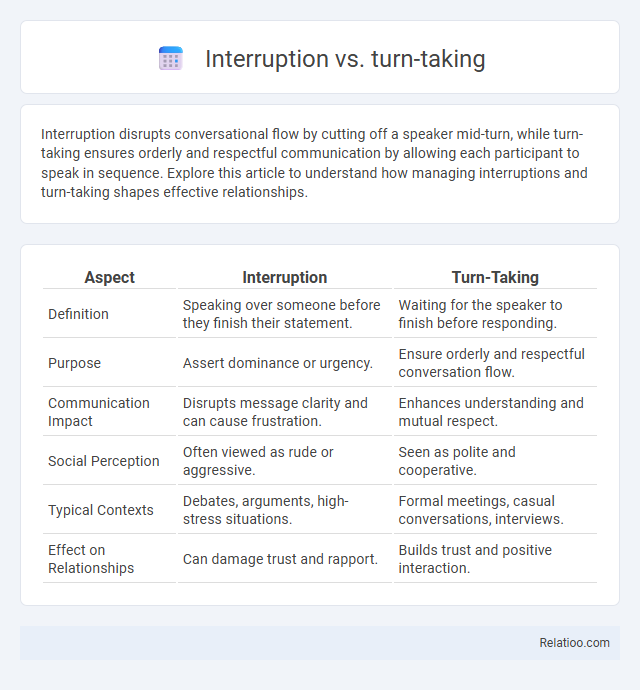Interruption disrupts conversational flow by cutting off a speaker mid-turn, while turn-taking ensures orderly and respectful communication by allowing each participant to speak in sequence. Explore this article to understand how managing interruptions and turn-taking shapes effective relationships.
Table of Comparison
| Aspect | Interruption | Turn-Taking |
|---|---|---|
| Definition | Speaking over someone before they finish their statement. | Waiting for the speaker to finish before responding. |
| Purpose | Assert dominance or urgency. | Ensure orderly and respectful conversation flow. |
| Communication Impact | Disrupts message clarity and can cause frustration. | Enhances understanding and mutual respect. |
| Social Perception | Often viewed as rude or aggressive. | Seen as polite and cooperative. |
| Typical Contexts | Debates, arguments, high-stress situations. | Formal meetings, casual conversations, interviews. |
| Effect on Relationships | Can damage trust and rapport. | Builds trust and positive interaction. |
Understanding Conversational Dynamics
Understanding conversational dynamics involves recognizing the subtle differences between turn-taking and interruption, both of which shape dialogue flow. Turn-taking is a cooperative process ensuring smooth exchanges, whereas interruptions occur when one speaker breaks in, often shifting control or direction. Mastering these nuances enhances your ability to navigate conversations with greater awareness and effectiveness.
Defining Interruption in Communication
Interruption in communication occurs when a speaker is cut off before completing their thought, disrupting the natural flow of conversation and potentially causing misunderstanding. Unlike turn-taking, which is a cooperative and orderly exchange of speaking roles, interruption is often abrupt and can signal dominance, impatience, or disagreement. Understanding the distinction helps you navigate social interactions more effectively, ensuring smoother and more respectful communication.
What is Turn-taking?
Turn-taking is a fundamental conversational mechanism that organizes how participants alternate speaking in dialogue, ensuring orderly communication flow. It involves cues such as intonation, pauses, and body language that signal when a speaker intends to yield or hold the floor, minimizing overlap and confusion. Unlike interruptions, which disrupt the current speaker, turn-taking fosters cooperative exchanges by allowing each participant a chance to contribute without undue intrusion.
The Psychological Impact of Interruption
Interruption during conversations disrupts cognitive processing and increases stress levels by triggering feelings of frustration and helplessness. Turn-taking supports smoother communication flow, reducing anxiety and promoting mutual understanding. Frequent interruptions can impair attention and memory, negatively affecting interpersonal relationships and emotional well-being.
Social Norms Guiding Turn-taking
Social norms guiding turn-taking shape effective communication by signaling when it is appropriate for you to speak or listen, ensuring conversations flow smoothly. Unlike interruptions, which breach these social protocols and disrupt the speaker's message, proper turn-taking respects the speaker's right to finish their thought. Understanding these unwritten rules enhances your social interactions by promoting mutual respect and clarity.
Cultural Variations in Conversational Flow
Cultural variations significantly influence the dynamics of interruption, turn-taking, and overlap in conversational flow, with some cultures perceiving interruptions as active engagement rather than rudeness. For instance, Latin American and Mediterranean societies often exhibit overlapping speech as a sign of enthusiasm and connection, contrasting with East Asian cultures where longer pauses and strict turn-taking signals respect and attentiveness. Understanding these cultural nuances is essential for effective cross-cultural communication and reducing misunderstandings in global interactions.
Interruption: Beneficial or Harmful?
Interruption in conversation can serve both beneficial and harmful roles depending on context and intent. You might find that interruptions facilitate dynamic exchanges by signaling engagement, emphasis, or clarification, enhancing collaborative communication. Conversely, frequent or aggressive interruptions often disrupt flow, diminish speaker confidence, and damage interpersonal rapport, highlighting the importance of mindful conversational balance.
Strategies to Foster Effective Turn-taking
Effective turn-taking involves strategies such as active listening, clear signaling, and respecting conversational cues to minimize interruptions. You can foster smooth transitions by using verbal and non-verbal signals like raising a hand or pausing, which help participants recognize when it's their turn to speak. Encouraging patience and feedback within group settings ensures balanced participation and reduces conversational conflicts caused by interruptions.
Managing Interruptions in Professional Settings
Effective management of interruptions in professional settings is crucial for maintaining productivity and respectful communication. Turn-taking ensures that conversations flow smoothly by allowing each participant to speak without being cut off, while managing interruptions involves tactfully addressing unexpected overlaps without disrupting the discussion's focus. Your ability to recognize and control interruptions fosters a collaborative environment where ideas are exchanged efficiently and with mutual respect.
Enhancing Communication Through Balanced Dialogue
Effective communication relies on understanding the distinctions between interruption, turn-taking, and overlap, which influence conversational flow and clarity. Turn-taking allows participants to express ideas without disruption, fostering respectful and coherent dialogue, whereas interruptions can hinder understanding and create tension. By mastering balanced dialogue techniques, you enhance your ability to engage in conversations that promote mutual respect and meaningful exchange.

Infographic: Interruption vs Turn-taking
 relatioo.com
relatioo.com